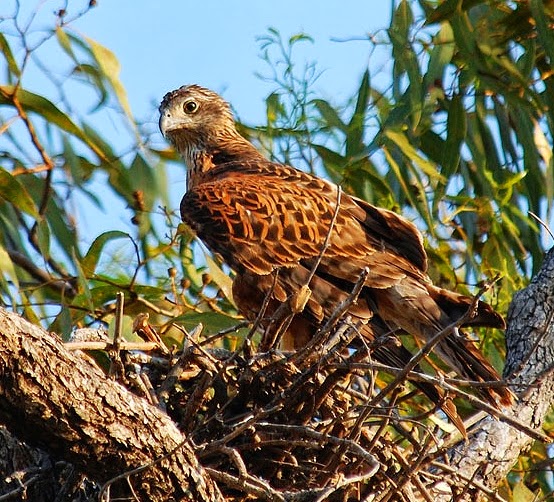 |
| Photo by Patrick Ingremeau (PBase) |
Common name:
red goshawk (en); açor-vermelho (pt); autour rouge (fr); azor rojo (es); fuchshabicht (de)
Taxonomy:
Order Falconiformes
Family Accipitridae
Range:
This species is endemic to Australia, being sparsely distributed in the northern and north-eastern parts of the country, from western Kimberley Division to north-eastern New South Wales. There are also some records in central Australia probably referring to dispersive individuals.
Size:
These birds are 45-60 cm long and have a wingspan of 100-135 cm. The females are larger, weighing around 1,1 kg while the males weigh around 630 g.
Habitat:
The red goshawk is found in coastal and sub-coastal forests, including moist tropical forests, temperate forests, riverine forests, swamp forests and dry savannas. They are present from sea level up to an altitude of 1.000 m.
Diet:
They hunt mainly birds, particularly parrots, passerines, kookaburras, pigeons and cuckoos, but occasionally also larger prey such as ducks, herons and megapodes. Mammals, reptiles and insects are rarely taken.
Breeding:
Red goshawks breed in My-December. They are probably monogamous and breed in solitary pairs. The nest is a large structure made of dead sticks with a saucer-shaped hollow top, thickly lined with finer twigs and green eucalyptus leaves. It is placed on an exposed fork in a tall tree, 15-30 m above the ground, and within 1 km of a watercourse or wetland. The female lays 1-2 eggs, which she incubates alone for 39-43 days while the male brings her food. The chicks are fed by both parents and fledge 51-53 days after hatching, but continue to be receive food from the parents for another 70–80 days.
Conservation:
IUCN status – NT (Near-Threatened)
This species has a very large breeding range, but the global population is estimated at just 1.000-1.400 individuals. The population may be declining owing to habitat loss in at least eastern Queensland, but the rate of decline is not suspected to be rapid. Historical declines n this species were possibly caused by widespread clearance for agriculture, a problem still affecting the more northern populations. Other threats include egg collecting, forest fires, shooting, pesticide abuse and reduced prey abundance caused by loss or degradation of freshwater wetlands, loss of hollow-bearing trees in which prey breed, over-grazing by livestock and feral herbivores, and changed fire regimes.







